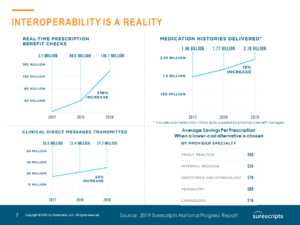What does it feel like to be a patient, provider, pharmacist, and payer in a world where interoperability is not always a reality? What improvements can be expected by healthcare stakeholders in a world where interoperability is vast?
In our October Webinar Series event – The Care We All Strive For: The Impact of Interoperability – our sponsor Surescripts helped to address the two above questions via a short two-act skit. Four fictional healthcare stakeholders – a patient, a provider, a pharmacist, and a health plan executive – each shared their experiences with how interoperability helps to address the Quadruple Aim: enriching the patient experience, improving outcomes, addressing costs, and maintaining provider well-being.
Access the entire recording here.
Two-Acts: Healthcare System Interoperability – Before & After
In Act I of the skit, each of the actors shared their experience in a world where interoperability is not a widespread reality – a world that most healthcare stakeholders experience today. In Act II, they shared how enhanced interoperability can improve the experience and well-being of not only patients and but also providers while reducing administrative and financial burdens and enhancing clinical outcomes – the four goals of the Quadruple Aim.
Highlights of Act I – Navigating Today’s Processes (Before)
Each stakeholder shared their experience living and working in a healthcare environment where interoperability is lacking:
Patient Carlos Garcia expressed his experience and concerns about alternative medication availability and cost:
- Need to repeat medical and medication history with each new provider
- Difficulty obtaining info on more cost-effective medication alternatives
- Lapses in medication adherence due to cost and/or delays at the pharmacy
Physician Dr. Natalie Pinter, Carlos Garcia’s PCP, noted difficult prior authorization processes and lack of access to benefits information:
- Administrative processes take time away from patient interaction
- Lack of benefits information makes identifying cheaper therapeutic alternatives more difficult
- Cumbersome prior authorization processes – particularly for specialty medications
Pharmacist Keisha Wright also expressed concerns about over-reliance on faxes and administrative burdens:
- Challenges with incomplete patient information
- Delays in filling prescriptions – particularly specialty medications – due to unwieldy prior authorization processes
VP of Pharmacy at Carlos’s health plan, Oscar Gustafsson, noted impacts his health plan pharmacy operations:
- Involve a heavy, over-reliance on faxes to communicate with physicians and pharmacists
- Challenges assisting with member medication adherence and addressing gaps
- Difficulty assisting members with optimizing the use of their health plan benefits
Navigating Today’s Healthcare Process is a Challenge for Everyone
After Act I, the emcee of the performance – Melissa Warnke, Director PBM-Pharmacy, Health Plan Segment Marketing of Surescripts – shared some recent statistics supporting how insufficient interoperability impacts patients, providers, pharmacists, and health plan payers.
Access the entire recording here.
Highlights of Act II – The Care We All Strive For (After)
In the 2nd act, the healthcare stakeholders shared how broad healthcare system interoperability would change stakeholder experience:
Health plan VP of Pharmacy Oscar noted improvements and efficiencies gained in health plan operations:
- Allows for timely delivery of medication adherence gaps directly into the workflow of physicians
- Ability to share member-specific benefit information to physicians at the point of care
- Faster, “faxless” processing and turnaround of prior authorizations
Patient Carlos noted positive impacts on his physician office visit, cost of his medications, and obtaining his medications:
- Ability to provide patient medical and medication history to new physicians and pharmacists
- Faster, less administratively intense prescriptions – particularly specialty medications – and refills of existing prescriptions
- Opportunity to save money with therapeutic alternatives
Physician Dr. Natalie revealed improved ability patient information, reduced administrative work, & more time with her patient:
- Patient medical info, medication history, and adherence gaps available electronically in advance of a patient encounter
- Electronically accessible benefit plan information facilitates identification and prescription of more cost-effective medication and treatment alternatives
- Submitting prior authorizations electronically without faxing
- Submitting prescriptions for specialty medications electronically to the pharmacy
Pharmacist Keisha Wright noted reduced patient data collection and streamlined medication processing:
- Complete patient and prior authorization info received electronically
- More timely processing – especially with specialty medications – allows for more time counseling patients
The Care We All Strive For – The Vast Reality of Improved Healthcare System Interoperability
At the conclusion of Act II, Surescripts Melissa Warnke shared an overview of the vast impact that improved interoperability can have on increasing the transactions that help address the Quadruple Aim. Melissa also shared some additional statistics showing the growing pervasiveness of interoperability. Click images to expand.
 |
 |
A Faxless Future: Dare We Dream?
After Melissa recapped Act II, a short, light-hearted video was played showing how fax machines might be re-purposed for a useful life after they retire from their long-running service to the healthcare industry. The following are a few examples of how fax machines might serve a new role. See the short video “A Faxless Future: Dare We Dream.”
 |
 |
 |
Questions from the Audience on Healthcare System Interoperability
After the video was played, emcee Melissa Warnke fielded some questions submitted by attendees. Here are a few of the questions and their responses:
- What have you seen as the best practices for driving the kind of behavior change from providers, pharmacists, and others that obtaining maximum value from increased interoperability takes?
Answer: 32:03 to 34:50
- Without a sales pitch, what are the new tools that the provider and pharmacist actors are alluding to that to speed the implementation and adoption of interoperability?
Answer: 37:08 to 40:07
- How has COVID-19 impacted the transaction counts (real-time benefit inquiries, medication history transmittals, clinical direct messages) you presented after Act II?
Answer: 41:45 to 45:16
- Can pharmacists see the same real-time prescription benefit info as providers?
Answer: 45:39 to 47:33
Connect & Interact w/ Our Sponsor Surescripts & HealthCare Executive Group
Our Webinar Series events are one example of how the HealthCare Executive Group helps to share information and promote collaboration between healthcare leaders, change-makers, and other stakeholders serving the healthcare industry.
For more information on the topics presented by Surescripts in our October Webinar Series:
- Visit their website: www.surescripts.com
- Contact Surescripts: https://surescripts.com/contact-us/
Learn more about the HealthCare Executive Group and to stay abreast of challenges, issues, and opportunities facing the healthcare industry in 2021 and beyond:
- Visit our website at www.hceg.org
- Follow us on Twitter at @HCExecGroup
- Connect with us on LinkedIn
- And consider joining our newsletter






